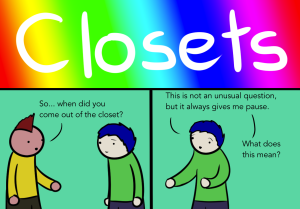
Source: GENEQ
Last week, I posted an article by a spouse of a transgender woman describing how difficult it is to suddenly become the other half in a non-traditional family unit.
It was immediately met with howls of protest by a number of transgender people I otherwise respect because they felt that there were already too many narratives out there about transgender lives being painful.
This reminds me of another instance in my own community, when it was found that another transgender woman was into kink. It was used to discredit her – and claim she wasn’t really transgender.
These incidents illustrate a phenomenon where transgender people feel compelled to stick to a script.
And most of the reasons have to do with various stigmas and a lack of acceptance being placed upon us by culture, psychology, and medicine.
When the pressure comes from sources internal to the transgender community, it’s often a result of acceptability politics and internalized transphobia.
Past acceptability politics included the National Organization for Women (NOW) disowning its lesbian members in the 1960s because Betty Friedan feared that outspoken lesbians were a threat to the feminist movement.
Setting up lesbians as a “Lavender Menace” created a rift that ultimately weakened the movement for women’s rights, and hurt queer women in particular. Even today, lesbian, bisexual, and transgender women suffer the most from economic disparities.
Here are ten ways in which we try and homogenize our transgender narratives, and why we do:
1. Marriage and Relationships
Something that’s rarely talked about is how difficult it is even for supportive spouses as their partner transitions.
Some of the most well-known success stories in the transgender community of relationships that survive transition gloss over the grieving process, the pain, the loss, the questions, and the lack of available support for non-transgender (cisgender) spouses.
Those partnerships that do survive the initial transition often face the daunting question of what to do now that they are a mixed orientation couple.
We avoid these stories because transgender people are already commonly accused of being selfish for transitioning.
The truth is far more complex and seems to follow an almost inevitable tragic arc of a classical Greek tragedy. In a Greek tragedy, the end is known from the beginning, and the actions that the characters take to try to avoid that destiny only more inescapably wrap them in that fate.
What makes Greek tragedies all the more gloomy is that the people in them are characters of nobility far beyond the normal, but whose human flaws end up creating a darker fate than that enjoyed by many people.
Both parties are suffering, and both do what has to be done at every step.
The only real answer to this is to greatly reduce the stigma of being transgender, so people are able to come out much earlier and not enter into unsustainable relationships.
2. Alternate Relationship Structures, Non-Monogamy, and Polyamory
When a marriage does survive transition, the sex life often doesn’t. This leaves many couples with few options: divorce, a sexless marriage, or some form of an alternate relationship structure.
The first is often unacceptable due to children, a sense of duty to each other, or finances. The second is often something neither party is willing to forgo. And this leaves the third as the most viable solution for many.
However, given the continuing stigma of even ethical polyamory (the non-possessive, honest, and responsible philosophy and practice of loving multiple people simultaneously), many transgender people in these situations feel like they have jumped right from one closet into another.
The irony of this is that up to 72% of all men cheat on their wives, yet acceptance of polyamory is only 14%. Then there’s the pressure – especially for public transgender figures – to sustain an image of a “happy mixed orientation marriage,” hiding relationship issues in order to be effective in the public arena.
3. Sexual Orientation
In the past year, a number of transgender women have been publicly insulted by other transgender community “leaders” for their sexual orientation, namely being attracted to women.
This is disturbing on so many levels.
First, wasn’t the whole point of the LGBTQIA+ movement to stop shaming people for their sexual orientation and gender identity?
Second, these attacks are eerily similar to the ones used by a small group of radical anti-transgender feminists, whose goal is “morally mandating it [transsexualism] out of existence.”
So why is being a transgender woman who is attracted to women stigmatized?
One mostly discredited psychologist, Ray Blanchard, rejects gender identity and labels transgender women based on their sexual orientation. In the 1980s, Blanchard developed a pseudo-science, un-falsifiable theory that all transgender women who are attracted to women are just heterosexual male fetishists.
Transgender women are still terrified of being given that label, even as conservatives try to use it to legislate transgender people out of existence as well.
4. Kink and BDSM
When it was revealed that the transgender woman at the center of a recent controversy was part of the kink/BDSM scene, some self-appointed “leaders” within the transgender community took it upon themselves to deny her gender identity.
While the transgender person at the center of this did absolutely nothing wrong, some members of the transgender community wanted to disown her because they felt she reflected badly on the community for her interests.
Much of this stigma comes from both Blanchard (again) and social conservatives pushing the false narrative that transgender people are perverts and predators.
The truth is that straights, gays, lesbians, bisexuals, and transgender people (among others!) can all be kinky.
When straight people are kinky, it makes over 160 million dollars at the box office and sells 100 million book copies. When transgender people are kinky, it’s grounds for excommunication from the community.
Also ironic is that the kink/BDSM community has often been one of the few welcoming safe spaces for transgender people. In an environment of sexual liberation and experimentation, transgender people are just part of the landscape.
5. Age at Which You Knew You Were Transgender
Much as there is a “born this way” narrative for queer people, so is there for transgender people.
Acceptance of LGBQ people is highly correlated with the understanding that sexual orientation is inborn.
This leads to transgender people feeling highly pressured to say “I always knew,” rather than admitting they didn’t feel dysphoric until puberty, or that they didn’t figure out what the conflict was until even later.
Failing to say you “always knew” unfairly casts doubt on the validity of your gender identity.
This pressure to conform is constant, even if multiple lines of research indicate biological origins of gender identity.
Worsening this situation for transgender women is Blanchard’s typology (also again), which labels anyone who “didn’t know” from birth a fetishist and probable pervert.
6. Sex Work
According to the 2011 National Transgender Discrimination Survey (NTDS), 11% of transgender people have done sex work to survive.
Involvement in the sex industry was found to be highly correlated with familial rejection, youth homelessness, bullying in school, and job discrimination.
In other words, people who are rejected by their families, thrown out of their homes as teens, beaten while at school, and can’t find jobs are much more likely to resort to the sex industry for survival.
These are the most innocent victims of cultural and religious discrimination against transgender people, yet we hesitate to lift their stories because of the stigma of the sex industry.
Media representation of transgender people as mostly sex workers, as well as police profiling due to that same perception, lead us to ignoring those who are forced to engage in survival sex industry work, and pretend it doesn’t happen.
This silence speaks volumes about all of us.
7. No Transition Regrets
First, here are the most important facts: Strong regrets about transition are rare, and access to transition related care is a medical necessity according to every major professional health organization.
However, there are a few (1-4%) people who regret medically transitioning. This is far lower than almost any other medical procedure, but it still happens from time to time.
Risk factors for negative regret mentioned in studies include lack of support from the patient’s family, poor social support, late-life transitions, severe psychopathology unrelated to gender dysphoria, unfavorable physical appearance, and poor surgical results.
I personally know of one case where a transgender woman who ended up with regrets was given an ultimatum by her medical team: undergo Gender Confirmation Surgery or lose access to your hormones. This incident violates everything that the World Professional Association of Transgender Health (WPATH) recommends.
Instead of talking about why regret happens and how to prevent it, though, we simply don’t.
This has a great deal to do with one person in particular who had undiagnosed psychological co-morbidities, wasn’t actually transgender, and now advocates against anyone having access to transition related medical care. His position is extremely harmful because it is frequently used by conservatives who really don’t have transgender people’s best interests at heart.
As a result, instead of talking about lack of education for mental health care providers, cultural discrimination, familiar rejection, and limited surgical training increasing what regret cases we do see, we say nothing at all, and people with regrets are reluctant to talk about it.
8. Mental Illness
The general public is loath to talk about mental illness in general, but for transgender people, this is even more pronounced.
Conservatives are pushing the narrative that all transgender people are mentally ill or perverts by definition, which makes it difficult to talk about actual instances of mental illness or to seek help for them.
Admitting that you have a problem is made even more difficult; it forces you to grapple with whether the haters are right about other things too.
Similarly, it isn’t something the community as a whole is comfortable discussing, given we’re still fighting against the narrative that we’re all suffering from a disorder.
9. Which Medical Treatments (If Any) a Transgender Individual Pursues
In many states, a transgender person’s legal rights are based on their surgical status.
There are also cisgender and transgender people who reject other people’s gender identities if they have not had, or do not want, particular medical interventions.
Oftentimes, cisgender people express that transgender people are only welcome in spaces and activities if they have had a particular surgery.
As a result, there is heavy pressure to at least say you want medical intervention.
Denying a desire for medical transition gives transphobes an excuse to say that transgender people don’t want to play by the same rules as everyone else, deny our identities, or use it as an excuse for discrimination.
Ignoring for a moment that most transgender people don’t have the money to pay for these procedures, much less insurance that covers them, the ideas behind this are chilling.
A person’s human rights should never be contingent upon undergoing massive surgery that they do not want.
We have been down this road before, and it doesn’t end well.
10. Non-Binary, Gender Fluid, Genderqueer, and Gender Non-Conforming (GNC) Identities
Our society thinks about gender as a binary, and as a result, the LGBTQIA+ movement’s messaging is that transgender women are women, and transgender men are men.
When non-binary, gender non-conforming, or gender fluid people enter the conversation, it disrupts well-tested talking points and invites a lot of questions we really aren’t good at answering yet:
What bathrooms should they use? Will gender identity and expression change from day to day? Does this make it a choice? What about gender markers on ID? What about gendered dress standards at work? Is gender identity fixed, or can it be changed via reparative therapy?
We often avoid talking about these types of identities because it complicates our efforts for acceptance, even though everyone’s identity should be respected.
However, we risk painting ourselves into a legislative and legal corner down the road if we ignore GNC identities now.
This issue cannot be put off indefinitely. More and more high school and college aged people identify as somewhere on the GNC spectrum, and they deserve to have their narratives shared as well.
***
In the end, it’s ironic that many transgender people spend their lives pursuing an authentic existence, only to dive right back into new closets.
When we fight for acceptance, it should be for people who actually exist – not just for an idealized cardboard cut-out of ourselves.
[do_widget id=”text-101″]
Brynn Tannehill is a parent, writer, scientist, and advocate who has written for OutServe magazine, The New Civil Rights Movement, the Huffington Post, and Queer Mental Health as a blogger and featured columnist. Check out her writing here and follow her on Twitter @BrynnTannehill.
Search our 3000+ articles!
Read our articles about:
Our online racial justice training
Used by hundreds of universities, non-profits, and businesses.
Click to learn more




















